Managing Employment Relations: A Comparison of Australia and India
VerifiedAdded on 2022/11/18
|8
|2612
|334
Report
AI Summary
This report provides a comprehensive comparison of employment relations in Australia and India, analyzing the roles of the state, unions, and employers in each country. It explores the historical context, legal frameworks, and key developments in industrial relations, including the impact of legislation like the Fair Work Act in Australia and the liberalization of labor laws in India. The analysis covers the evolution and current state of union density, the influence of political factors, and the strategies employed by employers' organizations. The report highlights the differences in approaches to wage determination, flexible working arrangements, and gender equality, offering insights into the challenges and opportunities within each national context. By examining the interplay of these factors, the report offers a nuanced understanding of the dynamics shaping employment relations in both Australia and India.

Managing employment relation
Paraphrase This Document
Need a fresh take? Get an instant paraphrase of this document with our AI Paraphraser

Managing employment relation 1
Compare, contrast and critically assess employment relations of state, unions and
employers in Australia with India
The employment relations actors (state, unions, and employers) in Australia have
been compared with India in this paper. Since 1990s, the industrial associations system of
Australia has experienced several changes like substantial judicial change, structural change,
falloffs in the union solidity and power, and increase in non-standard procedures of
employment. The centralized industrial associations system has made shift to the
decentralized system concentrating on enterprise negotiating. The population of Australia is
estimated at 21 million and GDP more than US $1 trillion. Out of 21 million, 10 million
public in Australia are identified belonging to the labor force. 75% of the labor force is
engaged in services whereas 20% are in the production and construction sector. The
Australian economy is greatly relied on the mining and cultivation industries, whereas such
industries retaining 5% of the complete workers. The country has practiced robust economic
growth from 1980s to 2007. Only two years faced a sharp downturn 1990 and 1991. The
employment relations on the basis of state have caused shifts in the forms of employment.
The organization of employment has reformed drastically in current years. There is drop in
full-time employment which is even identified as permanent employment. The several types
of non-standard employment have made expansion in the unplanned work, outsourcing,
provisional jobs and use of the activities and rest labor market mediators. Most of the jobs
generated during 1990s were deliberated to be casual only whereas freelance jobs were the
rapidly growing concern of employment. When it comes to the political context, the state has
been a confederation which is a government structure with the chief federal government and
6 local state governments. The federal government is restricted to making laws were allied to
manufacturing relations under the composition of Australia. Earlier all the industrial
commandments were originally under the authority of the states. When it comes to the legal
context, an arbitration system was formed in 1904 and functioned until 1988. This system
was strictly restricted to the engineering clashes after the boundaries of the provincial states.
The industrial relations act was passed in 1988 and more implications were announced in
1993 in the form of the industrial reforms. It incorporated certain obligation to safeguard
industrial action while a elected bargaining period. When it comes to working choices
legislation, workplace relations act was introduced in 1996 which restricted the influence of
the Australian engineering associations commission (McPhail, et al. 2015). The ‘work
choices’ were introduced in 2005. It initiated five minimum employment conditions. Further,
Compare, contrast and critically assess employment relations of state, unions and
employers in Australia with India
The employment relations actors (state, unions, and employers) in Australia have
been compared with India in this paper. Since 1990s, the industrial associations system of
Australia has experienced several changes like substantial judicial change, structural change,
falloffs in the union solidity and power, and increase in non-standard procedures of
employment. The centralized industrial associations system has made shift to the
decentralized system concentrating on enterprise negotiating. The population of Australia is
estimated at 21 million and GDP more than US $1 trillion. Out of 21 million, 10 million
public in Australia are identified belonging to the labor force. 75% of the labor force is
engaged in services whereas 20% are in the production and construction sector. The
Australian economy is greatly relied on the mining and cultivation industries, whereas such
industries retaining 5% of the complete workers. The country has practiced robust economic
growth from 1980s to 2007. Only two years faced a sharp downturn 1990 and 1991. The
employment relations on the basis of state have caused shifts in the forms of employment.
The organization of employment has reformed drastically in current years. There is drop in
full-time employment which is even identified as permanent employment. The several types
of non-standard employment have made expansion in the unplanned work, outsourcing,
provisional jobs and use of the activities and rest labor market mediators. Most of the jobs
generated during 1990s were deliberated to be casual only whereas freelance jobs were the
rapidly growing concern of employment. When it comes to the political context, the state has
been a confederation which is a government structure with the chief federal government and
6 local state governments. The federal government is restricted to making laws were allied to
manufacturing relations under the composition of Australia. Earlier all the industrial
commandments were originally under the authority of the states. When it comes to the legal
context, an arbitration system was formed in 1904 and functioned until 1988. This system
was strictly restricted to the engineering clashes after the boundaries of the provincial states.
The industrial relations act was passed in 1988 and more implications were announced in
1993 in the form of the industrial reforms. It incorporated certain obligation to safeguard
industrial action while a elected bargaining period. When it comes to working choices
legislation, workplace relations act was introduced in 1996 which restricted the influence of
the Australian engineering associations commission (McPhail, et al. 2015). The ‘work
choices’ were introduced in 2005. It initiated five minimum employment conditions. Further,
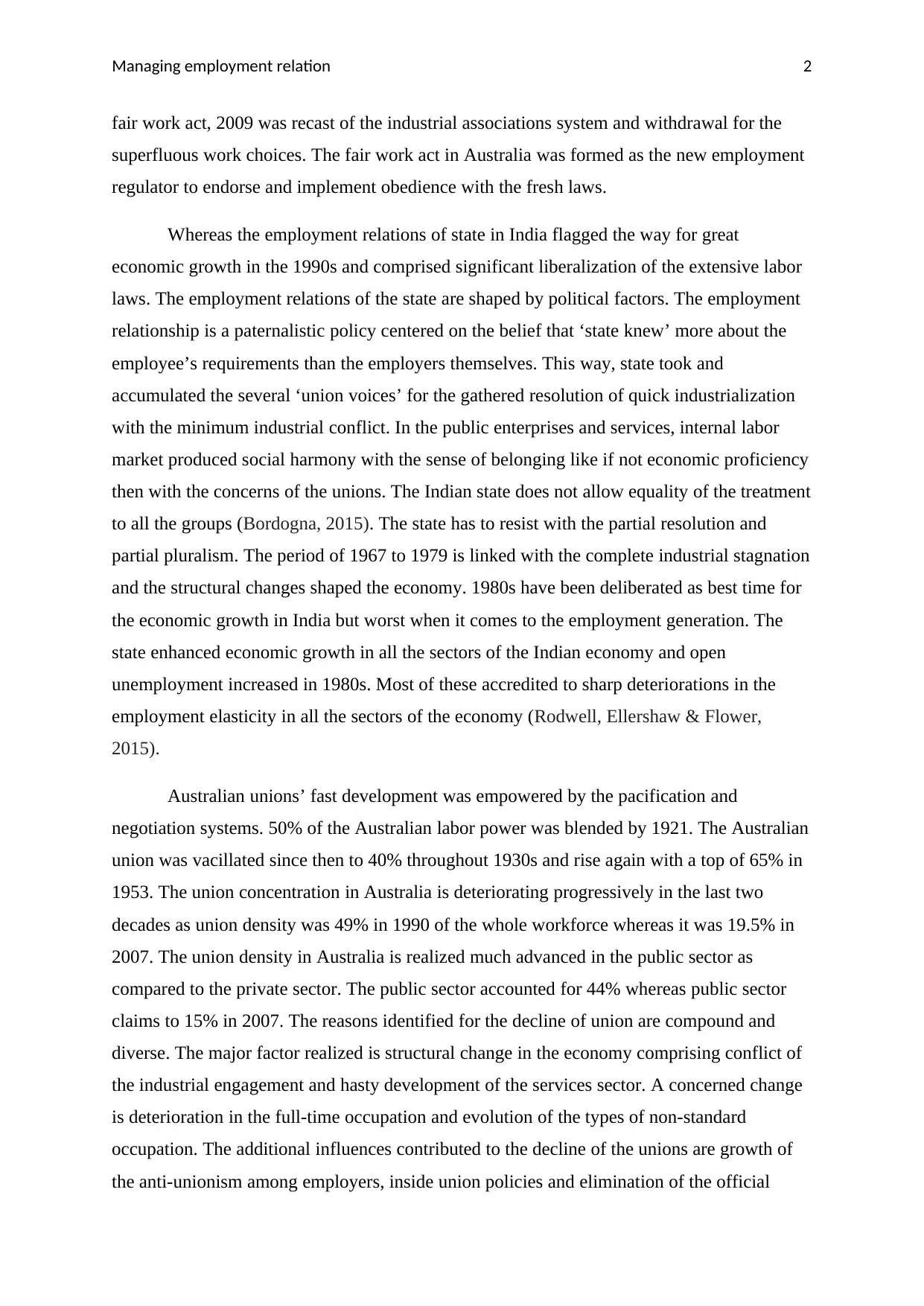
Managing employment relation 2
fair work act, 2009 was recast of the industrial associations system and withdrawal for the
superfluous work choices. The fair work act in Australia was formed as the new employment
regulator to endorse and implement obedience with the fresh laws.
Whereas the employment relations of state in India flagged the way for great
economic growth in the 1990s and comprised significant liberalization of the extensive labor
laws. The employment relations of the state are shaped by political factors. The employment
relationship is a paternalistic policy centered on the belief that ‘state knew’ more about the
employee’s requirements than the employers themselves. This way, state took and
accumulated the several ‘union voices’ for the gathered resolution of quick industrialization
with the minimum industrial conflict. In the public enterprises and services, internal labor
market produced social harmony with the sense of belonging like if not economic proficiency
then with the concerns of the unions. The Indian state does not allow equality of the treatment
to all the groups (Bordogna, 2015). The state has to resist with the partial resolution and
partial pluralism. The period of 1967 to 1979 is linked with the complete industrial stagnation
and the structural changes shaped the economy. 1980s have been deliberated as best time for
the economic growth in India but worst when it comes to the employment generation. The
state enhanced economic growth in all the sectors of the Indian economy and open
unemployment increased in 1980s. Most of these accredited to sharp deteriorations in the
employment elasticity in all the sectors of the economy (Rodwell, Ellershaw & Flower,
2015).
Australian unions’ fast development was empowered by the pacification and
negotiation systems. 50% of the Australian labor power was blended by 1921. The Australian
union was vacillated since then to 40% throughout 1930s and rise again with a top of 65% in
1953. The union concentration in Australia is deteriorating progressively in the last two
decades as union density was 49% in 1990 of the whole workforce whereas it was 19.5% in
2007. The union density in Australia is realized much advanced in the public sector as
compared to the private sector. The public sector accounted for 44% whereas public sector
claims to 15% in 2007. The reasons identified for the decline of union are compound and
diverse. The major factor realized is structural change in the economy comprising conflict of
the industrial engagement and hasty development of the services sector. A concerned change
is deterioration in the full-time occupation and evolution of the types of non-standard
occupation. The additional influences contributed to the decline of the unions are growth of
the anti-unionism among employers, inside union policies and elimination of the official
fair work act, 2009 was recast of the industrial associations system and withdrawal for the
superfluous work choices. The fair work act in Australia was formed as the new employment
regulator to endorse and implement obedience with the fresh laws.
Whereas the employment relations of state in India flagged the way for great
economic growth in the 1990s and comprised significant liberalization of the extensive labor
laws. The employment relations of the state are shaped by political factors. The employment
relationship is a paternalistic policy centered on the belief that ‘state knew’ more about the
employee’s requirements than the employers themselves. This way, state took and
accumulated the several ‘union voices’ for the gathered resolution of quick industrialization
with the minimum industrial conflict. In the public enterprises and services, internal labor
market produced social harmony with the sense of belonging like if not economic proficiency
then with the concerns of the unions. The Indian state does not allow equality of the treatment
to all the groups (Bordogna, 2015). The state has to resist with the partial resolution and
partial pluralism. The period of 1967 to 1979 is linked with the complete industrial stagnation
and the structural changes shaped the economy. 1980s have been deliberated as best time for
the economic growth in India but worst when it comes to the employment generation. The
state enhanced economic growth in all the sectors of the Indian economy and open
unemployment increased in 1980s. Most of these accredited to sharp deteriorations in the
employment elasticity in all the sectors of the economy (Rodwell, Ellershaw & Flower,
2015).
Australian unions’ fast development was empowered by the pacification and
negotiation systems. 50% of the Australian labor power was blended by 1921. The Australian
union was vacillated since then to 40% throughout 1930s and rise again with a top of 65% in
1953. The union concentration in Australia is deteriorating progressively in the last two
decades as union density was 49% in 1990 of the whole workforce whereas it was 19.5% in
2007. The union density in Australia is realized much advanced in the public sector as
compared to the private sector. The public sector accounted for 44% whereas public sector
claims to 15% in 2007. The reasons identified for the decline of union are compound and
diverse. The major factor realized is structural change in the economy comprising conflict of
the industrial engagement and hasty development of the services sector. A concerned change
is deterioration in the full-time occupation and evolution of the types of non-standard
occupation. The additional influences contributed to the decline of the unions are growth of
the anti-unionism among employers, inside union policies and elimination of the official
⊘ This is a preview!⊘
Do you want full access?
Subscribe today to unlock all pages.

Trusted by 1+ million students worldwide
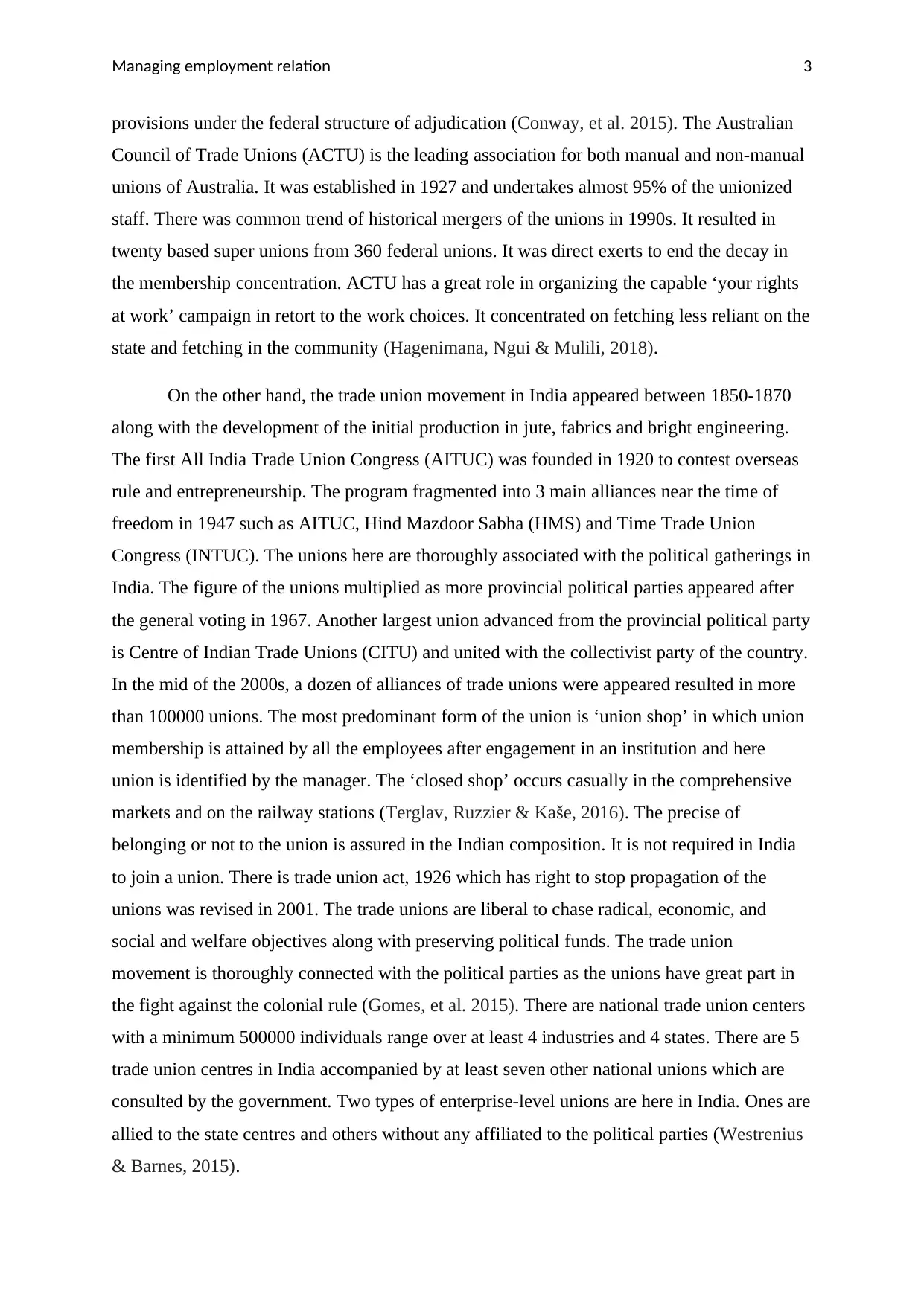
Managing employment relation 3
provisions under the federal structure of adjudication (Conway, et al. 2015). The Australian
Council of Trade Unions (ACTU) is the leading association for both manual and non-manual
unions of Australia. It was established in 1927 and undertakes almost 95% of the unionized
staff. There was common trend of historical mergers of the unions in 1990s. It resulted in
twenty based super unions from 360 federal unions. It was direct exerts to end the decay in
the membership concentration. ACTU has a great role in organizing the capable ‘your rights
at work’ campaign in retort to the work choices. It concentrated on fetching less reliant on the
state and fetching in the community (Hagenimana, Ngui & Mulili, 2018).
On the other hand, the trade union movement in India appeared between 1850-1870
along with the development of the initial production in jute, fabrics and bright engineering.
The first All India Trade Union Congress (AITUC) was founded in 1920 to contest overseas
rule and entrepreneurship. The program fragmented into 3 main alliances near the time of
freedom in 1947 such as AITUC, Hind Mazdoor Sabha (HMS) and Time Trade Union
Congress (INTUC). The unions here are thoroughly associated with the political gatherings in
India. The figure of the unions multiplied as more provincial political parties appeared after
the general voting in 1967. Another largest union advanced from the provincial political party
is Centre of Indian Trade Unions (CITU) and united with the collectivist party of the country.
In the mid of the 2000s, a dozen of alliances of trade unions were appeared resulted in more
than 100000 unions. The most predominant form of the union is ‘union shop’ in which union
membership is attained by all the employees after engagement in an institution and here
union is identified by the manager. The ‘closed shop’ occurs casually in the comprehensive
markets and on the railway stations (Terglav, Ruzzier & Kaše, 2016). The precise of
belonging or not to the union is assured in the Indian composition. It is not required in India
to join a union. There is trade union act, 1926 which has right to stop propagation of the
unions was revised in 2001. The trade unions are liberal to chase radical, economic, and
social and welfare objectives along with preserving political funds. The trade union
movement is thoroughly connected with the political parties as the unions have great part in
the fight against the colonial rule (Gomes, et al. 2015). There are national trade union centers
with a minimum 500000 individuals range over at least 4 industries and 4 states. There are 5
trade union centres in India accompanied by at least seven other national unions which are
consulted by the government. Two types of enterprise-level unions are here in India. Ones are
allied to the state centres and others without any affiliated to the political parties (Westrenius
& Barnes, 2015).
provisions under the federal structure of adjudication (Conway, et al. 2015). The Australian
Council of Trade Unions (ACTU) is the leading association for both manual and non-manual
unions of Australia. It was established in 1927 and undertakes almost 95% of the unionized
staff. There was common trend of historical mergers of the unions in 1990s. It resulted in
twenty based super unions from 360 federal unions. It was direct exerts to end the decay in
the membership concentration. ACTU has a great role in organizing the capable ‘your rights
at work’ campaign in retort to the work choices. It concentrated on fetching less reliant on the
state and fetching in the community (Hagenimana, Ngui & Mulili, 2018).
On the other hand, the trade union movement in India appeared between 1850-1870
along with the development of the initial production in jute, fabrics and bright engineering.
The first All India Trade Union Congress (AITUC) was founded in 1920 to contest overseas
rule and entrepreneurship. The program fragmented into 3 main alliances near the time of
freedom in 1947 such as AITUC, Hind Mazdoor Sabha (HMS) and Time Trade Union
Congress (INTUC). The unions here are thoroughly associated with the political gatherings in
India. The figure of the unions multiplied as more provincial political parties appeared after
the general voting in 1967. Another largest union advanced from the provincial political party
is Centre of Indian Trade Unions (CITU) and united with the collectivist party of the country.
In the mid of the 2000s, a dozen of alliances of trade unions were appeared resulted in more
than 100000 unions. The most predominant form of the union is ‘union shop’ in which union
membership is attained by all the employees after engagement in an institution and here
union is identified by the manager. The ‘closed shop’ occurs casually in the comprehensive
markets and on the railway stations (Terglav, Ruzzier & Kaše, 2016). The precise of
belonging or not to the union is assured in the Indian composition. It is not required in India
to join a union. There is trade union act, 1926 which has right to stop propagation of the
unions was revised in 2001. The trade unions are liberal to chase radical, economic, and
social and welfare objectives along with preserving political funds. The trade union
movement is thoroughly connected with the political parties as the unions have great part in
the fight against the colonial rule (Gomes, et al. 2015). There are national trade union centers
with a minimum 500000 individuals range over at least 4 industries and 4 states. There are 5
trade union centres in India accompanied by at least seven other national unions which are
consulted by the government. Two types of enterprise-level unions are here in India. Ones are
allied to the state centres and others without any affiliated to the political parties (Westrenius
& Barnes, 2015).
Paraphrase This Document
Need a fresh take? Get an instant paraphrase of this document with our AI Paraphraser
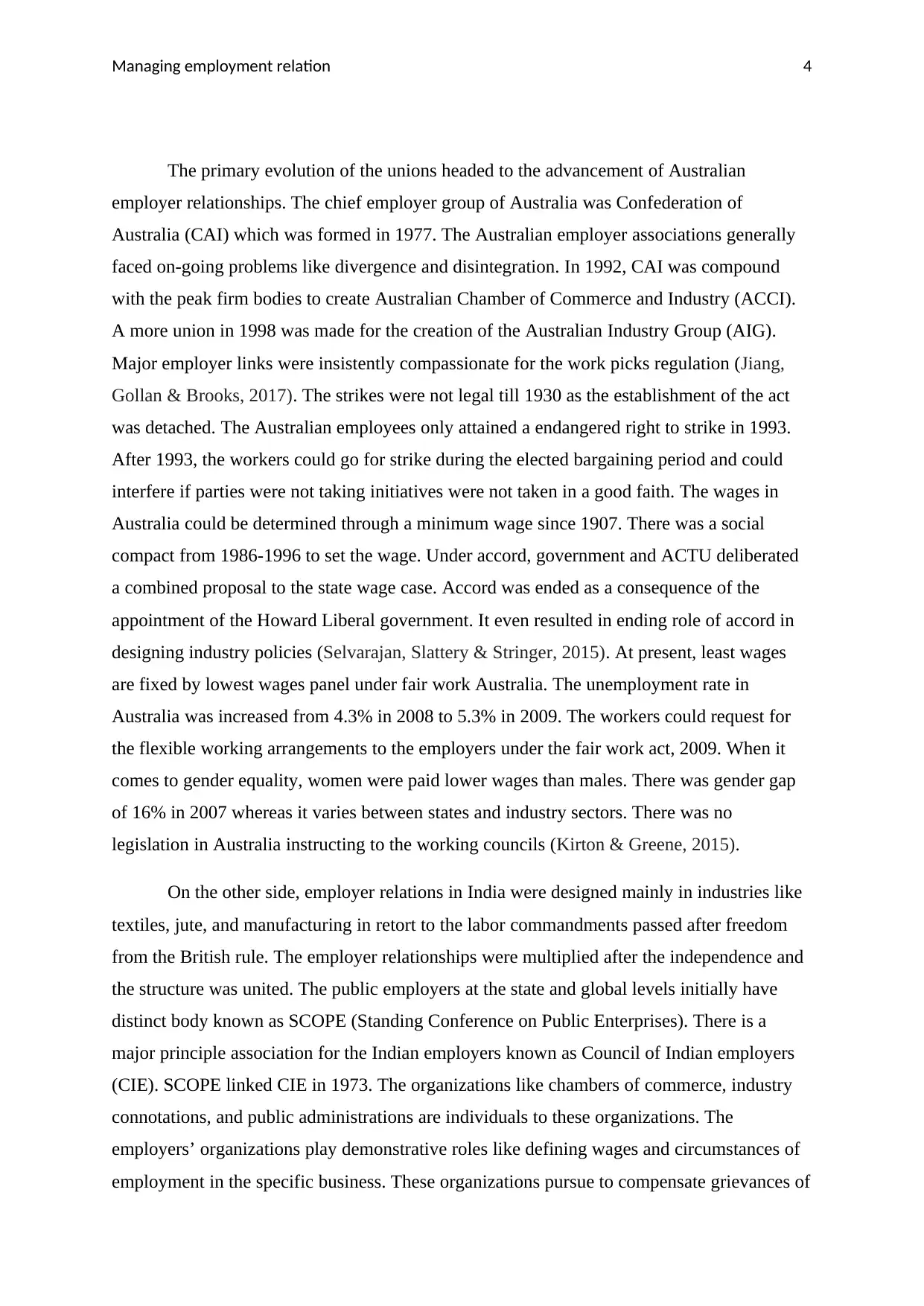
Managing employment relation 4
The primary evolution of the unions headed to the advancement of Australian
employer relationships. The chief employer group of Australia was Confederation of
Australia (CAI) which was formed in 1977. The Australian employer associations generally
faced on-going problems like divergence and disintegration. In 1992, CAI was compound
with the peak firm bodies to create Australian Chamber of Commerce and Industry (ACCI).
A more union in 1998 was made for the creation of the Australian Industry Group (AIG).
Major employer links were insistently compassionate for the work picks regulation (Jiang,
Gollan & Brooks, 2017). The strikes were not legal till 1930 as the establishment of the act
was detached. The Australian employees only attained a endangered right to strike in 1993.
After 1993, the workers could go for strike during the elected bargaining period and could
interfere if parties were not taking initiatives were not taken in a good faith. The wages in
Australia could be determined through a minimum wage since 1907. There was a social
compact from 1986-1996 to set the wage. Under accord, government and ACTU deliberated
a combined proposal to the state wage case. Accord was ended as a consequence of the
appointment of the Howard Liberal government. It even resulted in ending role of accord in
designing industry policies (Selvarajan, Slattery & Stringer, 2015). At present, least wages
are fixed by lowest wages panel under fair work Australia. The unemployment rate in
Australia was increased from 4.3% in 2008 to 5.3% in 2009. The workers could request for
the flexible working arrangements to the employers under the fair work act, 2009. When it
comes to gender equality, women were paid lower wages than males. There was gender gap
of 16% in 2007 whereas it varies between states and industry sectors. There was no
legislation in Australia instructing to the working councils (Kirton & Greene, 2015).
On the other side, employer relations in India were designed mainly in industries like
textiles, jute, and manufacturing in retort to the labor commandments passed after freedom
from the British rule. The employer relationships were multiplied after the independence and
the structure was united. The public employers at the state and global levels initially have
distinct body known as SCOPE (Standing Conference on Public Enterprises). There is a
major principle association for the Indian employers known as Council of Indian employers
(CIE). SCOPE linked CIE in 1973. The organizations like chambers of commerce, industry
connotations, and public administrations are individuals to these organizations. The
employers’ organizations play demonstrative roles like defining wages and circumstances of
employment in the specific business. These organizations pursue to compensate grievances of
The primary evolution of the unions headed to the advancement of Australian
employer relationships. The chief employer group of Australia was Confederation of
Australia (CAI) which was formed in 1977. The Australian employer associations generally
faced on-going problems like divergence and disintegration. In 1992, CAI was compound
with the peak firm bodies to create Australian Chamber of Commerce and Industry (ACCI).
A more union in 1998 was made for the creation of the Australian Industry Group (AIG).
Major employer links were insistently compassionate for the work picks regulation (Jiang,
Gollan & Brooks, 2017). The strikes were not legal till 1930 as the establishment of the act
was detached. The Australian employees only attained a endangered right to strike in 1993.
After 1993, the workers could go for strike during the elected bargaining period and could
interfere if parties were not taking initiatives were not taken in a good faith. The wages in
Australia could be determined through a minimum wage since 1907. There was a social
compact from 1986-1996 to set the wage. Under accord, government and ACTU deliberated
a combined proposal to the state wage case. Accord was ended as a consequence of the
appointment of the Howard Liberal government. It even resulted in ending role of accord in
designing industry policies (Selvarajan, Slattery & Stringer, 2015). At present, least wages
are fixed by lowest wages panel under fair work Australia. The unemployment rate in
Australia was increased from 4.3% in 2008 to 5.3% in 2009. The workers could request for
the flexible working arrangements to the employers under the fair work act, 2009. When it
comes to gender equality, women were paid lower wages than males. There was gender gap
of 16% in 2007 whereas it varies between states and industry sectors. There was no
legislation in Australia instructing to the working councils (Kirton & Greene, 2015).
On the other side, employer relations in India were designed mainly in industries like
textiles, jute, and manufacturing in retort to the labor commandments passed after freedom
from the British rule. The employer relationships were multiplied after the independence and
the structure was united. The public employers at the state and global levels initially have
distinct body known as SCOPE (Standing Conference on Public Enterprises). There is a
major principle association for the Indian employers known as Council of Indian employers
(CIE). SCOPE linked CIE in 1973. The organizations like chambers of commerce, industry
connotations, and public administrations are individuals to these organizations. The
employers’ organizations play demonstrative roles like defining wages and circumstances of
employment in the specific business. These organizations pursue to compensate grievances of
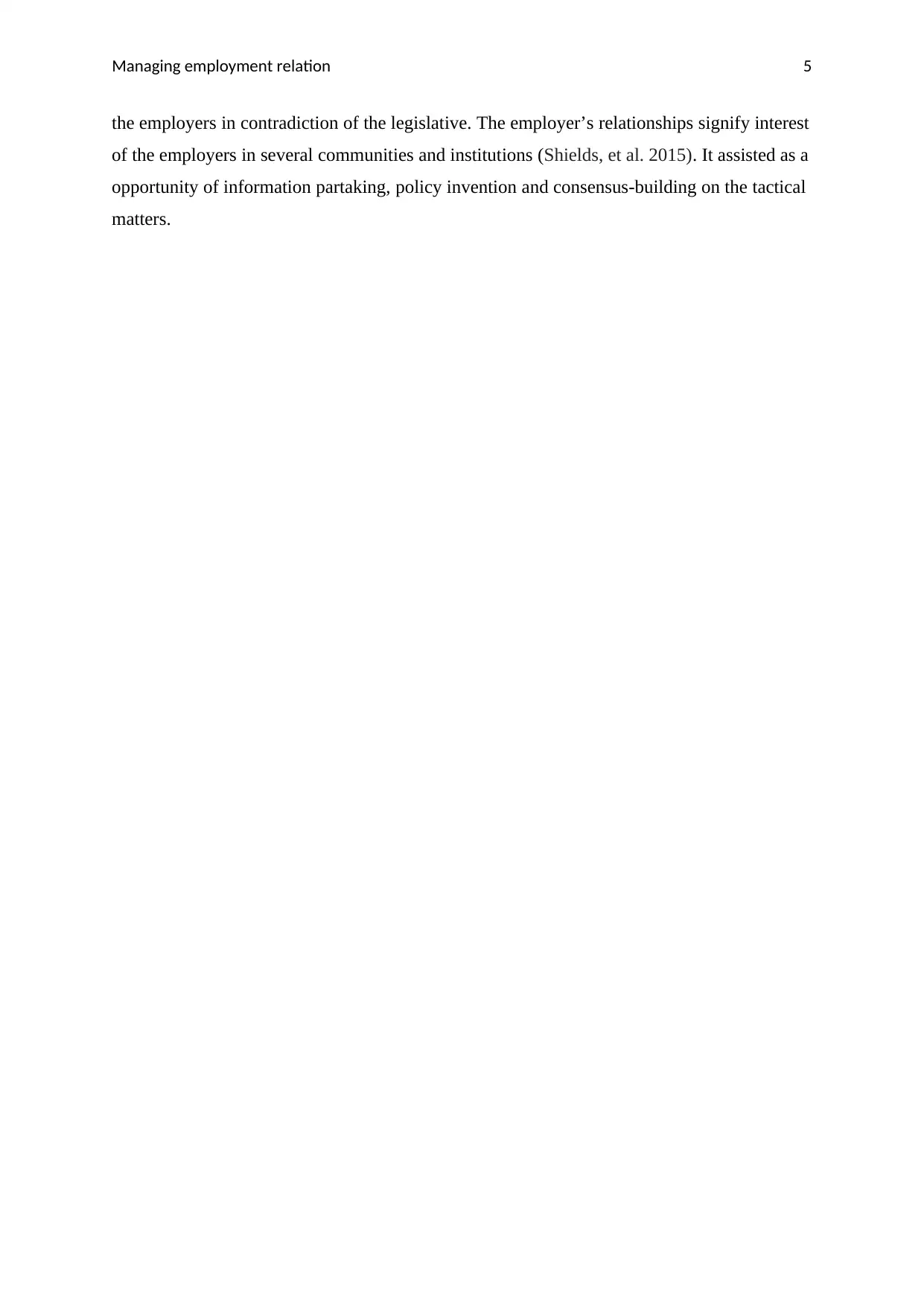
Managing employment relation 5
the employers in contradiction of the legislative. The employer’s relationships signify interest
of the employers in several communities and institutions (Shields, et al. 2015). It assisted as a
opportunity of information partaking, policy invention and consensus-building on the tactical
matters.
the employers in contradiction of the legislative. The employer’s relationships signify interest
of the employers in several communities and institutions (Shields, et al. 2015). It assisted as a
opportunity of information partaking, policy invention and consensus-building on the tactical
matters.
⊘ This is a preview!⊘
Do you want full access?
Subscribe today to unlock all pages.

Trusted by 1+ million students worldwide
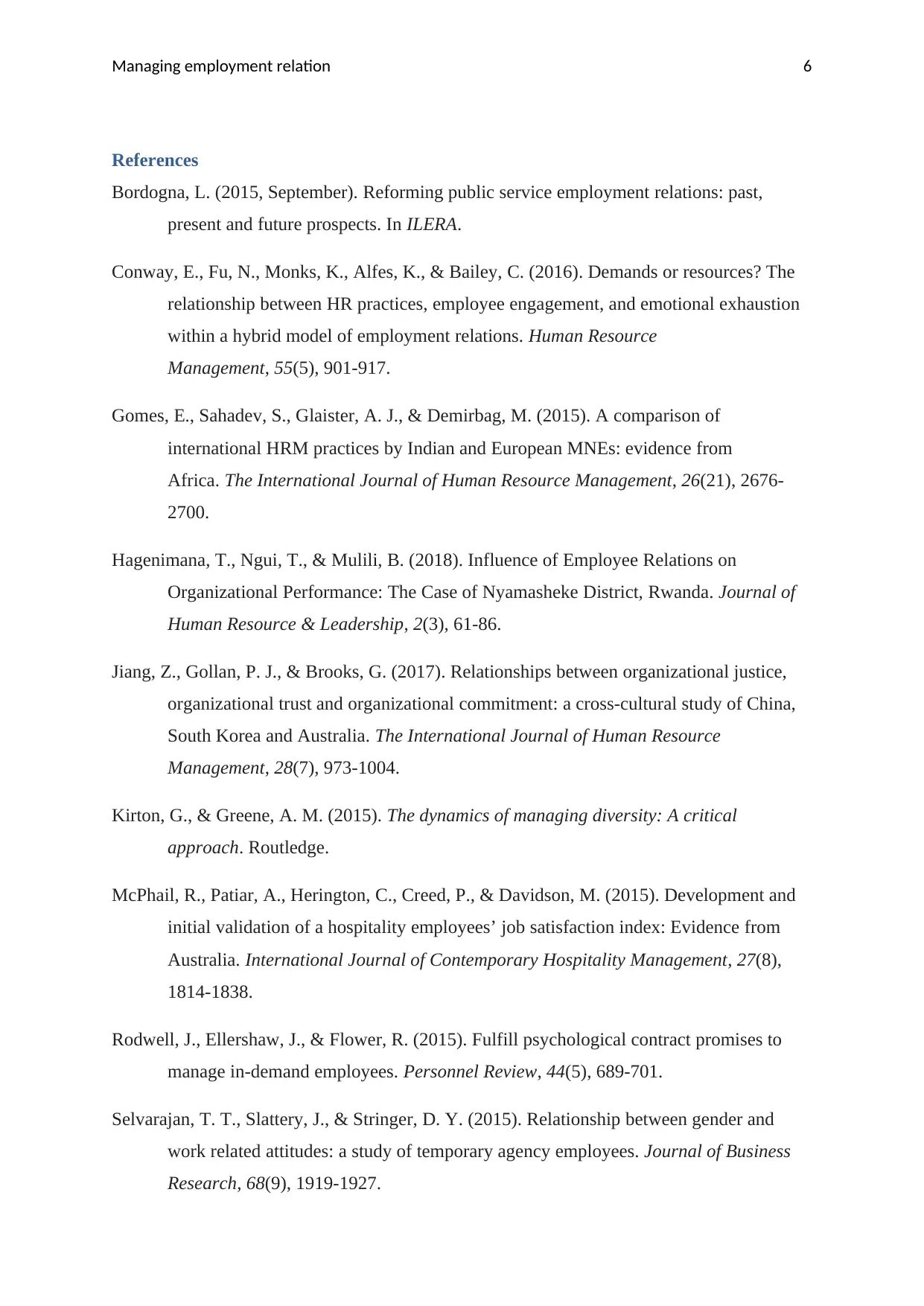
Managing employment relation 6
References
Bordogna, L. (2015, September). Reforming public service employment relations: past,
present and future prospects. In ILERA.
Conway, E., Fu, N., Monks, K., Alfes, K., & Bailey, C. (2016). Demands or resources? The
relationship between HR practices, employee engagement, and emotional exhaustion
within a hybrid model of employment relations. Human Resource
Management, 55(5), 901-917.
Gomes, E., Sahadev, S., Glaister, A. J., & Demirbag, M. (2015). A comparison of
international HRM practices by Indian and European MNEs: evidence from
Africa. The International Journal of Human Resource Management, 26(21), 2676-
2700.
Hagenimana, T., Ngui, T., & Mulili, B. (2018). Influence of Employee Relations on
Organizational Performance: The Case of Nyamasheke District, Rwanda. Journal of
Human Resource & Leadership, 2(3), 61-86.
Jiang, Z., Gollan, P. J., & Brooks, G. (2017). Relationships between organizational justice,
organizational trust and organizational commitment: a cross-cultural study of China,
South Korea and Australia. The International Journal of Human Resource
Management, 28(7), 973-1004.
Kirton, G., & Greene, A. M. (2015). The dynamics of managing diversity: A critical
approach. Routledge.
McPhail, R., Patiar, A., Herington, C., Creed, P., & Davidson, M. (2015). Development and
initial validation of a hospitality employees’ job satisfaction index: Evidence from
Australia. International Journal of Contemporary Hospitality Management, 27(8),
1814-1838.
Rodwell, J., Ellershaw, J., & Flower, R. (2015). Fulfill psychological contract promises to
manage in-demand employees. Personnel Review, 44(5), 689-701.
Selvarajan, T. T., Slattery, J., & Stringer, D. Y. (2015). Relationship between gender and
work related attitudes: a study of temporary agency employees. Journal of Business
Research, 68(9), 1919-1927.
References
Bordogna, L. (2015, September). Reforming public service employment relations: past,
present and future prospects. In ILERA.
Conway, E., Fu, N., Monks, K., Alfes, K., & Bailey, C. (2016). Demands or resources? The
relationship between HR practices, employee engagement, and emotional exhaustion
within a hybrid model of employment relations. Human Resource
Management, 55(5), 901-917.
Gomes, E., Sahadev, S., Glaister, A. J., & Demirbag, M. (2015). A comparison of
international HRM practices by Indian and European MNEs: evidence from
Africa. The International Journal of Human Resource Management, 26(21), 2676-
2700.
Hagenimana, T., Ngui, T., & Mulili, B. (2018). Influence of Employee Relations on
Organizational Performance: The Case of Nyamasheke District, Rwanda. Journal of
Human Resource & Leadership, 2(3), 61-86.
Jiang, Z., Gollan, P. J., & Brooks, G. (2017). Relationships between organizational justice,
organizational trust and organizational commitment: a cross-cultural study of China,
South Korea and Australia. The International Journal of Human Resource
Management, 28(7), 973-1004.
Kirton, G., & Greene, A. M. (2015). The dynamics of managing diversity: A critical
approach. Routledge.
McPhail, R., Patiar, A., Herington, C., Creed, P., & Davidson, M. (2015). Development and
initial validation of a hospitality employees’ job satisfaction index: Evidence from
Australia. International Journal of Contemporary Hospitality Management, 27(8),
1814-1838.
Rodwell, J., Ellershaw, J., & Flower, R. (2015). Fulfill psychological contract promises to
manage in-demand employees. Personnel Review, 44(5), 689-701.
Selvarajan, T. T., Slattery, J., & Stringer, D. Y. (2015). Relationship between gender and
work related attitudes: a study of temporary agency employees. Journal of Business
Research, 68(9), 1919-1927.
Paraphrase This Document
Need a fresh take? Get an instant paraphrase of this document with our AI Paraphraser
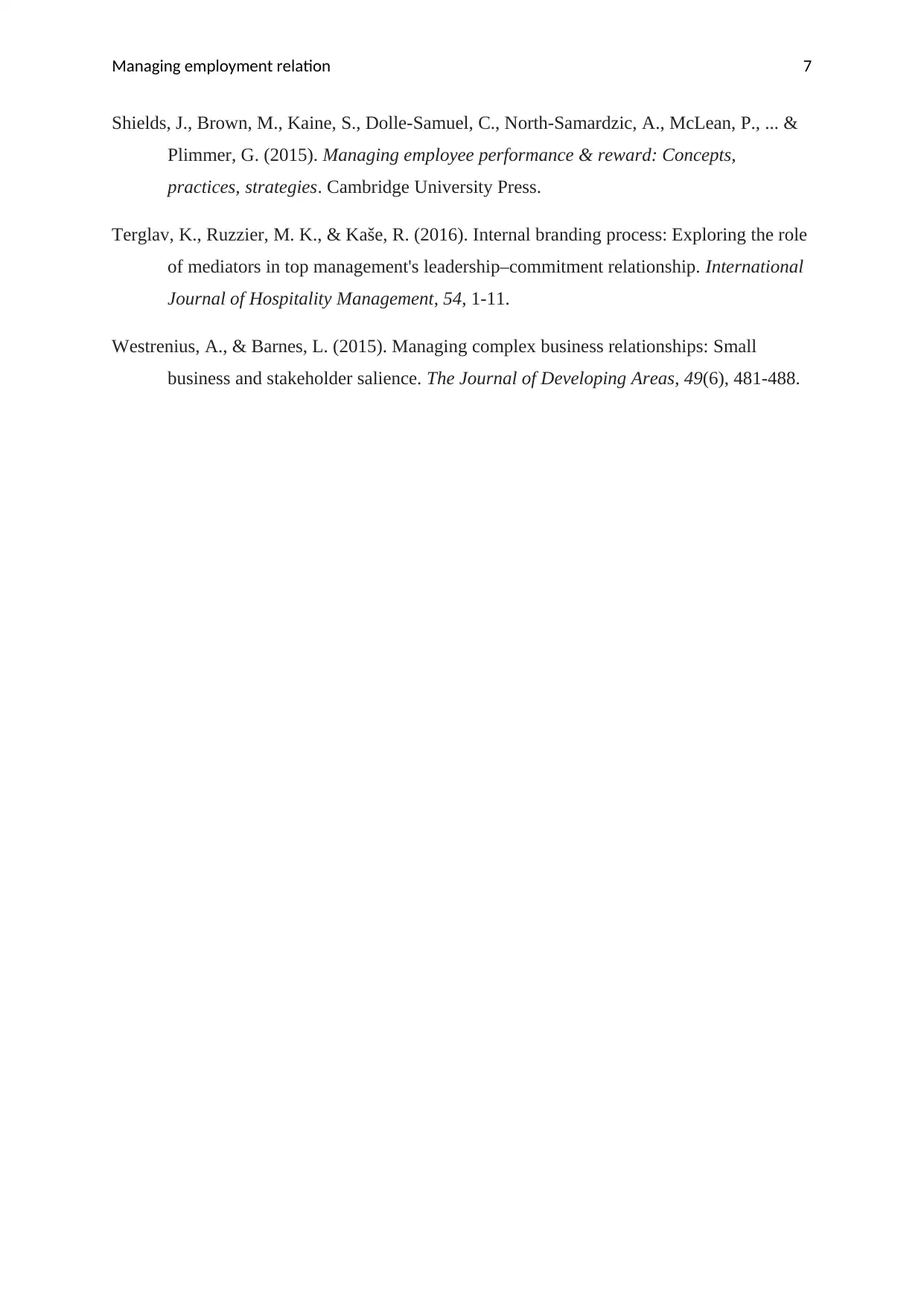
Managing employment relation 7
Shields, J., Brown, M., Kaine, S., Dolle-Samuel, C., North-Samardzic, A., McLean, P., ... &
Plimmer, G. (2015). Managing employee performance & reward: Concepts,
practices, strategies. Cambridge University Press.
Terglav, K., Ruzzier, M. K., & Kaše, R. (2016). Internal branding process: Exploring the role
of mediators in top management's leadership–commitment relationship. International
Journal of Hospitality Management, 54, 1-11.
Westrenius, A., & Barnes, L. (2015). Managing complex business relationships: Small
business and stakeholder salience. The Journal of Developing Areas, 49(6), 481-488.
Shields, J., Brown, M., Kaine, S., Dolle-Samuel, C., North-Samardzic, A., McLean, P., ... &
Plimmer, G. (2015). Managing employee performance & reward: Concepts,
practices, strategies. Cambridge University Press.
Terglav, K., Ruzzier, M. K., & Kaše, R. (2016). Internal branding process: Exploring the role
of mediators in top management's leadership–commitment relationship. International
Journal of Hospitality Management, 54, 1-11.
Westrenius, A., & Barnes, L. (2015). Managing complex business relationships: Small
business and stakeholder salience. The Journal of Developing Areas, 49(6), 481-488.
1 out of 8
Related Documents
Your All-in-One AI-Powered Toolkit for Academic Success.
+13062052269
info@desklib.com
Available 24*7 on WhatsApp / Email
![[object Object]](/_next/static/media/star-bottom.7253800d.svg)
Unlock your academic potential
Copyright © 2020–2025 A2Z Services. All Rights Reserved. Developed and managed by ZUCOL.




